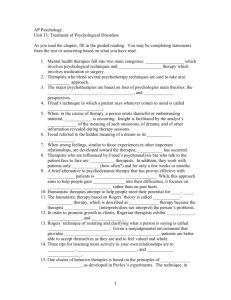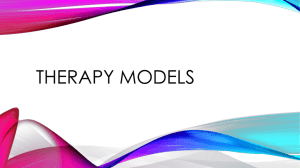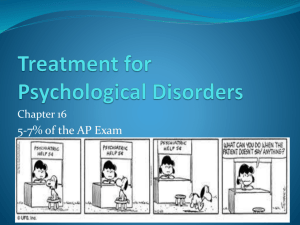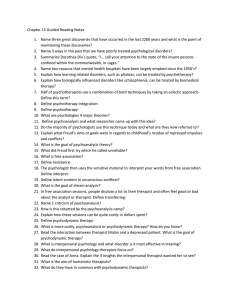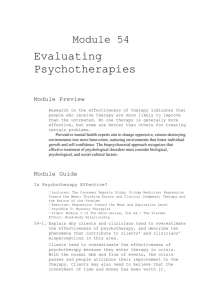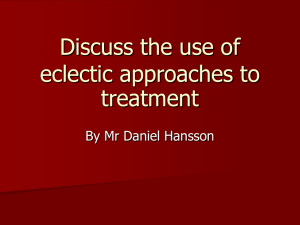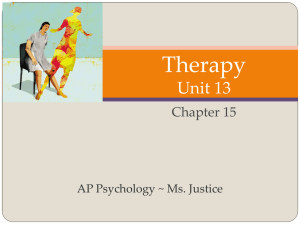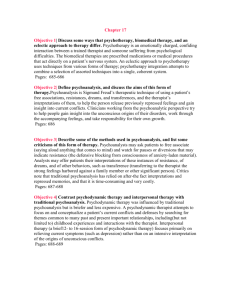File - notes
advertisement
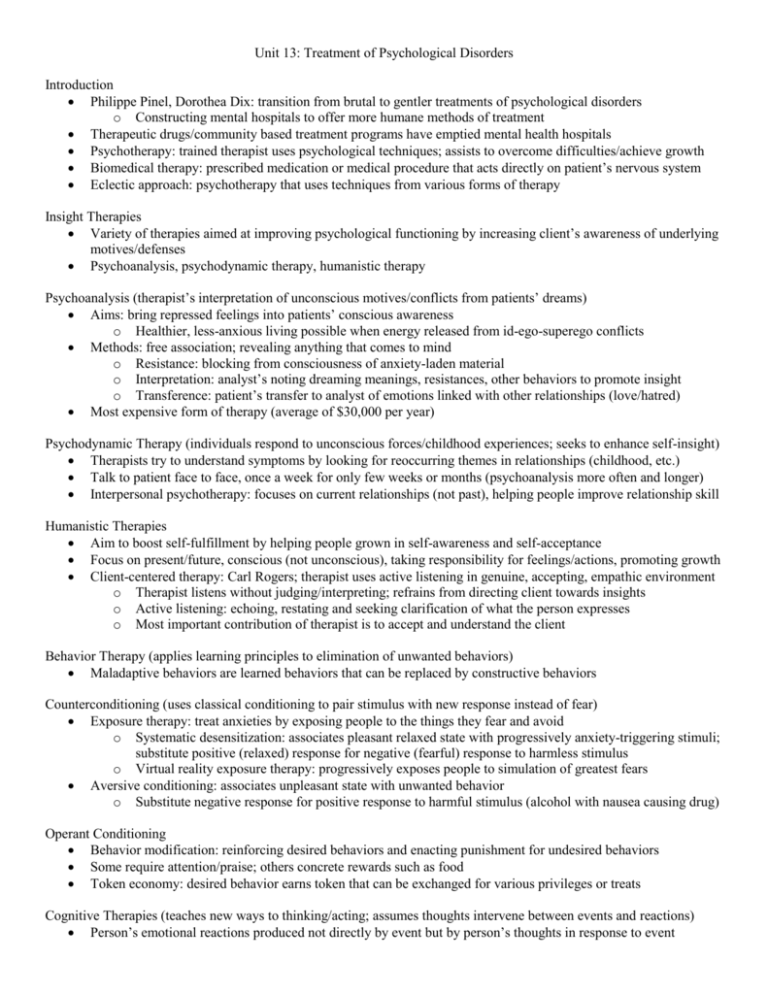
Unit 13: Treatment of Psychological Disorders Introduction Philippe Pinel, Dorothea Dix: transition from brutal to gentler treatments of psychological disorders o Constructing mental hospitals to offer more humane methods of treatment Therapeutic drugs/community based treatment programs have emptied mental health hospitals Psychotherapy: trained therapist uses psychological techniques; assists to overcome difficulties/achieve growth Biomedical therapy: prescribed medication or medical procedure that acts directly on patient’s nervous system Eclectic approach: psychotherapy that uses techniques from various forms of therapy Insight Therapies Variety of therapies aimed at improving psychological functioning by increasing client’s awareness of underlying motives/defenses Psychoanalysis, psychodynamic therapy, humanistic therapy Psychoanalysis (therapist’s interpretation of unconscious motives/conflicts from patients’ dreams) Aims: bring repressed feelings into patients’ conscious awareness o Healthier, less-anxious living possible when energy released from id-ego-superego conflicts Methods: free association; revealing anything that comes to mind o Resistance: blocking from consciousness of anxiety-laden material o Interpretation: analyst’s noting dreaming meanings, resistances, other behaviors to promote insight o Transference: patient’s transfer to analyst of emotions linked with other relationships (love/hatred) Most expensive form of therapy (average of $30,000 per year) Psychodynamic Therapy (individuals respond to unconscious forces/childhood experiences; seeks to enhance self-insight) Therapists try to understand symptoms by looking for reoccurring themes in relationships (childhood, etc.) Talk to patient face to face, once a week for only few weeks or months (psychoanalysis more often and longer) Interpersonal psychotherapy: focuses on current relationships (not past), helping people improve relationship skill Humanistic Therapies Aim to boost self-fulfillment by helping people grown in self-awareness and self-acceptance Focus on present/future, conscious (not unconscious), taking responsibility for feelings/actions, promoting growth Client-centered therapy: Carl Rogers; therapist uses active listening in genuine, accepting, empathic environment o Therapist listens without judging/interpreting; refrains from directing client towards insights o Active listening: echoing, restating and seeking clarification of what the person expresses o Most important contribution of therapist is to accept and understand the client Behavior Therapy (applies learning principles to elimination of unwanted behaviors) Maladaptive behaviors are learned behaviors that can be replaced by constructive behaviors Counterconditioning (uses classical conditioning to pair stimulus with new response instead of fear) Exposure therapy: treat anxieties by exposing people to the things they fear and avoid o Systematic desensitization: associates pleasant relaxed state with progressively anxiety-triggering stimuli; substitute positive (relaxed) response for negative (fearful) response to harmless stimulus o Virtual reality exposure therapy: progressively exposes people to simulation of greatest fears Aversive conditioning: associates unpleasant state with unwanted behavior o Substitute negative response for positive response to harmful stimulus (alcohol with nausea causing drug) Operant Conditioning Behavior modification: reinforcing desired behaviors and enacting punishment for undesired behaviors Some require attention/praise; others concrete rewards such as food Token economy: desired behavior earns token that can be exchanged for various privileges or treats Cognitive Therapies (teaches new ways to thinking/acting; assumes thoughts intervene between events and reactions) Person’s emotional reactions produced not directly by event but by person’s thoughts in response to event Beck’s Therapy for Depression Patients had catastrophizing beliefs about themselves, situations and futures when experienced depression Uses gentle questioning and persuasion to reveal irrational thinking and convince that life is not as ruined as seen Getting people to change what they say to themselves is effective way to change their thinking Stress inoculation training: teaching people to restructure their thinking in stressful situations Cognitive-Behavioral Therapy (combines cognitive therapy with behavior therapy) Aims to alter the way people think about and react to situations Replace catastrophizing thinking with realistic appraisals and practice behaviors incompatible with problem Ex: OCD people would think “I have compulsive urge” and instead play instrument instead of OCD behavior Group/Family Therapies Saves therapist’s time and client’s money Therapist guides interactions of group of people as they engage issues and react to one another o Individual discover similar thinking in other; feel relief that they are not alone; others share same problem Family therapy: treats family as system; individuals behavior is influenced by or directed at other family member o Individuals struggle to differentiate from family but also connect to them; causes tension and stress Most support groups focus on hard to discuss illness (e.g. cancer instead of hypertension or migraines) Is Psychotherapy Effective? Clients’ perceptions: people enter therapy in crisis/low point: will feel improvement; need to believe therapy was worth effort/money; clients speak well of therapists even when problems remain: therapists tried to help them Clinicians’ perceptions: treasure compliments but hear little from those not helped; think therapy always works Outcome research: Eysenck 2/3 of people improve with/without treatment, regression towards the mean o Meta-analysis: procedure for statistically combining the results of many different research studies o Those not undergoing therapy often improve but those undergoing therapy more likely to improve o For those that seek psychological treatment, search for other medical treatment drops Relative Effectiveness of Different Therapies Not one type of therapy is superior to another The more specific the problem the greater the chance of therapy working Evidence-based practice: clinical decision-making comprised of clinical expertise, best available research and patient’s values, characteristics, preferences, circumstances Eye Movement Desensitization and Reprocessing (EMDR) People imagine traumatic scenes while therapist triggers eye movements by waving finger in front of patient eyes Proven to be somewhat effective when compared with no treatment Light Exposure Therapy Seasonal affective disorder: form of depression occurring during the winter Sparks activity in brain region influencing body’s arousal/hormones; works as effectively as antidepressants Commonalities among Psychotherapies Hope for demoralized people; new perspective on oneself/world and empathic, trusting, caring relationship Culture/Values in Psychotherapy Clients matched with therapists that shared cultural values perceived more empathy and stronger alliance Ellis/Bergin: therapists differ sharply; differences can affect their view of healthy person Biomedical Therapy (prescribed medications/medical procedures that act directly on patient’s nervous system) Psychopharmacology (study of drug effects on mind and behavior) Enthusiasm for new drug diminishes after researchers subtract rates of: o Normal recovery among untreated persons o Recovery due to placebo effect Antipsychotic Drugs (treat schizophrenia and other forms of severe thought disorder) Chlorpromazine: dampens responsiveness to irrelevant stimuli; block dopamine receptors Tardive dyskinesia: involuntary movements of facial muscles, tongue, limbs, produced by long-term use Clozapine: targets dopamine and serotonin receptors to alleviate negative symptoms Antianxiety Drugs (drugs used to control anxiety and agitation) Xanax/Ativan: depresses central nervous system activity Criticism: reduce symptoms without resolving underlying problems; can cause psychological dependence on drug Antidepressants (used to treat depression; now increasingly prescribed for anxiety) Increase availability of norepinephrine/serotonin (elevate arousal/mood; scarce during depression) o Prozac, Zoloft, Paxil: blocks reabsorption and removal of serotonin from synapses o Selective-serotonin-reuptake-inhibitors (SSRIs) Administering thought patch reduce side effects (dry mouth, weight gain, hypertension) Drugs influence neurotransmission within hours but require weeks for full psychological effect Aerobic exercise has same effect and better benefits for those with mild-moderate depression Antidepressant medications: biggest improvement in those that are severely depressed (only prescribed for them) Mood-Stabilizing Medications Depakote and Lithium: effective mood stabilizers for those suffering emotional high and low of bipolar disorder Electroconvulsive Therapy (ECT) (biomedical therapy for severely depressed patients; electric current sent through brain) General anesthetic/muscle relaxant to prevent injury from convulsions before delivered electrical current to brain Some memory loss for treatment period but no discernible brain damage Repetitive Transcranial Magnetic Stimulation (rTMS) (repeated pulse of magnetic waves to brain; effective in depression) Psychosurgery (surgery that removes or destroys brain tissue) Moniz: lobotomy (cuts nerves connecting frontal lobes to emotion-controlling centers of brain; rare) Decreased person’s misery/tension but produced permanently lethargic, immature and uncreative person Therapeutic Life-Style Change Strenuous physical activity, strong community ties, sunlight exposure, plenty of sleep = no depression 12 week training program to reduce depression: aerobic exercise, adequate sleep, light exposure, social connection, anti-rumination (positive thinking), nutritional supplements for healthy brain functioning Preventing Psychological Disorders Resilience: personal strength that helps most people cope with stress and recover from adversity and trauma Prevent problem by fixing bad situation and developing coping abilities than wait for problem to arise and treat it Albee: poverty, meaningless work, criticism, unemployment, racism, sexism undermine people’s sense of competence, personal control and self-esteem; should support programs that alleviate demoralizing situations


